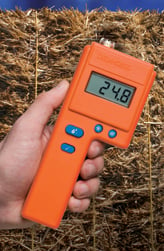 When shopping for a hay moisture meter, farmers need a tool that’s both rugged and accurate. However, finding a high-quality device for measuring moisture in hay can be a bit tougher than you might think.
When shopping for a hay moisture meter, farmers need a tool that’s both rugged and accurate. However, finding a high-quality device for measuring moisture in hay can be a bit tougher than you might think.
There are a lot of things that you’ll want to check for when picking out a moisture meter for hay. Some of your needs might change depending on whether you need to check moisture in loose hay in the windrow, baled hay being prepped for storage, or if you want to keep an eye on hay moisture while you’re baling.
To make sure you get the right tool to meet your needs, here’s a quick checklist for buying a hay moisture meter:
[ ] Determine Whether You Need a Device for Testing Loose or Baled Hay
Measuring moisture in loose hay is a bit different from testing baled hay. For loose hay in the windrow, a meter that uses an electrode with a disc-shaped prod is the best way to measure moisture. This is because the loose hay will have a lot of open pockets of air, which the multiple pin-points of a probe such as the 831 short pin prod helps to overcome.
Hay bales, on the other hand, are better measured with a long, reinforced prod that can reach the interior of the bale to get a reading of moisture conditions near the core of the bale. The length of the prod should be at least 1/2 to 2/3 the thickness of your hay bales.
[ ] Check the Construction of the Meter’s Casing
Conditions in the field can be tough on even the most rugged farming equipment. Any tool you take into the field should be built to last. When comparing hay meters, be sure to examine the casing.
Is the casing strong, or does it feel light and cheaply-made?
Flimsy meter cases won’t protect their sensitive internal components from the rigors of farming work, leading to more problems later on.
[ ] Check the Meter’s Moisture Range
A hay meter wouldn’t be very useful if it couldn’t accurately measure moisture across the recommended range for your particular type of hay bale.
The optimum moisture content of a hay bale will vary based on type of forage and bale density, but the most common ranges are:
- Small Square Bales: 18-20% MC
- Large Square Bales: 12-16% MC
- Round Bales: 15%MC
Any type of meter you use to measure moisture in hay should at least be able to accurately detect moisture over a range of 8% to 30% MC, just to make sure you’re seeing actual measurements rather than just an indicator that the hay is above or below measurable %MC range.
[ ] Continuous Mode for Baler-Mounted Units
If you’re looking to measure moisture in hay as you’re baling, you’ll need a meter that has a continuous mode for checking hay in the baler. With this mode, you can keep an eye on the moisture conditions of your hay bales without having to leave the cab of your tractor.
[ ] Calibration Checks
Over time, even the best moisture testing tools can lose accuracy. To ensure that you’re getting the right readings, there should be a quick and easy way for you to check the meter’s calibration.
For a hay meter, this can be done with either a Moisture Content Standard (MCS) or a built-in calibration check. An MCS is a tool that is built to return a specific reading value when connected to a moisture sensor probe. If the reading result is different from this value, then the meter is off-calibration and needs to be fixed.
Built-in checks do the same thing as an MCS, but without the need for an external device.
[ ] Manufacturer Warrantees
How strong is the manufacturer’s warranty?
If the warranty uses simple language that clearly defines what is and isn’t covered, and how repairs/replacements will be handled, odds are that the manufacturer knows they have a quality product.
On the other hand, warrantees filled with legal double-speak complete with tons of exemptions for everyday use situations can indicate that the service and support you’ll receive after completing your purchase will be less than exemplary.
Going a step beyond to check how the manufacturer has worked with other customers on warranty service can create an even clearer picture of what you can expect after your purchase.
[ ] Manuals and Training Courses
Good toolmakers will have comprehensive online product manuals. Great toolmakers go a step further to provide training courses that ensure you can make the most out of your farming equipment.
Check out any online manuals, brochures, and training courses that a moisture meter manufacturer has on their website. Doing so can teach you a lot about the operation of their meter, such as how easy or complicated it will be to use.
Hopefully, this checklist can help you find the best moisture meter for checking your hay in the bale or the windrow. Feel free to print this checklist, or to check out some of our other resources about monitoring moisture in hay!

Comments